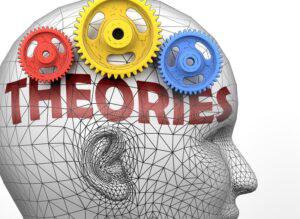
Theories are fundamental to practice, planning, and exploration. It is not necessary to read academic texts about theories prior to employing them, any more than it is necessary to read texts on reproductive medicine prior to having a newborn. Examining theories is practical and scientific because they have a significant impact on how evidence is gathered, understood, and applied.
1. Psychosexual Theory and Stages of Development
Clinical Significance
Each of Freud's five phases of psychosexual development corresponds to a specific age range, erogenous body part, and clinical consequence of fixation.
Stage I: 0-1 year, oral, mouth:
Newborns enjoy oral pleasure. An infant first bonds with his mother, who meets his oral demands. If the stimulation is insufficient, libidinal energy focuses on oral fulfillment, resulting in latent aggressive or passive inclinations.
Stage II: 1-3 years old, anal, bowel, and bladder:
Toilet training during this time is delicate. Parents' performance expectations shift libidinal energy from oral to anal. If the child misbehaves, he is more likely to be punished, feel inadequate, and receive a negative appraisal from a caregiver. Fixation at this stage might cause anal retentiveness (orderliness) or anal expulsiveness (whimsical disorder).
Stage III: 3-6 years old, phallic, genitalia:
This is when children start to like their genitalia. The Oedipus complex can begin during primitive sexual development.
Stage IV: 6 - 12 years old, latency, dormant sexual feelings:
This suppresses libido. No erogenous zone for this level. School, sports, and relationships now help the child act on their urges. This dysfunction prevents the youngster from forming good adult connections.
Stage V: 13-18 years old, genital, mature sexual feelings:
During this stage, the child's ego matures and they crave independence. Their sexuality is healthy and consensual, and they can form lifelong partnerships.

Freud's developmental theories serve as the foundation for psychoanalysis and its derivatives, which comprise modern psychotherapy.
2. Behavioral Model of Development
The remarkable legacy of B. F. Skinner has left an indelible mark on psychology and numerous other disciplines, from philosophy to education. Despite the fact that behaviorism is no longer the dominant school of thought, his contributions remain significant today.
For example, mental health personnel frequently employ Skinner's operant conditioning when interacting with clients. Teachers also frequently use reinforcement to influence classroom behavior. To train dogs and other animals, even animal trainers significantly rely on B. F. Skinner's methods.
Skinner's ABCs of Behaviorism
According to B. F. Skinner's theor, an individual is first exposed to a stimulus, which then elicits a response, which is then reinforced (stimulus, response, reinforcement). This is ultimately what determines our conduct.
To aid in remembering this procedure, the ABCs of behaviorism were created. Antecedent (stimulus), behavior (response), and consequence (reinforcement) comprise the ABCs.

Reinforcement
In B. F. Skinner's theory of learning, reinforcement is crucial to the development of behavior. Positive or negative events that strengthen a particular behavior are examples of reinforcement.
Positive reinforcement consists of actions or occurrences that strengthen a response by providing a stimulus for particular behaviors, such as rewarding or praising a child for cleansing his or her room. Negative reinforcement also strengthens a response, but by removing a negative consequence, such as when a child cleans their room to avoid being grounded.
According to B. F. Skinner's theory of learning, reinforcements develop or condition our behaviors. He referred to this process as operant conditioning, where the term "operant" refers to any behavior that interacts with the environment and has consequences.
Operant behaviors (actions we have control over) are distinct from respondent behaviors. Skinner defined respondent behaviors as anything that occurs reflexively or automatically, such as jerking your hand away from a hot pan if you contact it by accident.
3. Piaget’s Theory of Cognitive Development studied
According to Jean Piaget's theory of cognitive development, infants progress through four distinct stages of learning. His theory is not only concerned with how infants acquire knowledge but also with the nature of intelligence. Piaget's stages are:
· Sensorimotor stage: Birth to 2 years
· Preoperational stage: Ages 2 to 7
· Concrete operational stage: Ages 7 to 11
· Formal operational stage: Ages 12 and up

Piaget believed that children actively participate in the learning process, functioning as miniature scientists as they conduct experiments, make observations, and gain knowledge of the world. As children interact with the world around them, they perpetually acquire new information, expand their existing understanding, and modify previously held beliefs to accommodate new data.
4. Contextual Model of Development
Individuals' relationships with their physical, cognitive, and social environments are considered by contextual perspectives. In addition, they investigate sociocultural and environmental influences on growth.
Lev Vygotsky believed that social interaction plays a crucial role in children's learning; through these interactions, children undergo a continuous process of scaffolded learning. He believed that a child could acquire cognitive skills within a certain range known as the zone of proximal development by engaging in scaffolded participation with a teacher or capable peer.
The sociocultural theory of Vygotsky highlights the significance of culture and interaction in the development of cognitive skills. Vygotsky argued that thinking has social origins, that social interactions play a crucial role in the development of higher-order thinking skills, and that cognitive development cannot be completely understood apart from its social and historical context. "Every function in the cultural development of the child appears twice: first on the social level, and then on the individual level; first between people (interpsychological) and then inside the child (intrapsychological)," he explained.
The application of theory facilitates the comprehension of how and why interventions succeed or fail, as well as the key factors that predict success.
It is crucial to investigate the evolution of the human species. Because it provides a framework for considering human development, mental evolution, and, most importantly, learning. It is crucial to investigate these theories because it has a close relationship with the growth and learning habits of people.
REFERENCES:
https://pressbooks.nscc.ca/lumenlife/chapter/behavioral-and-cognitive-theories/
https://www.verywellmind.com/piagets-stages-of-cognitive-development-2795457
https://courses.lumenlearning.com/wm-lifespandevelopment/chapter/contextual-perspectives/